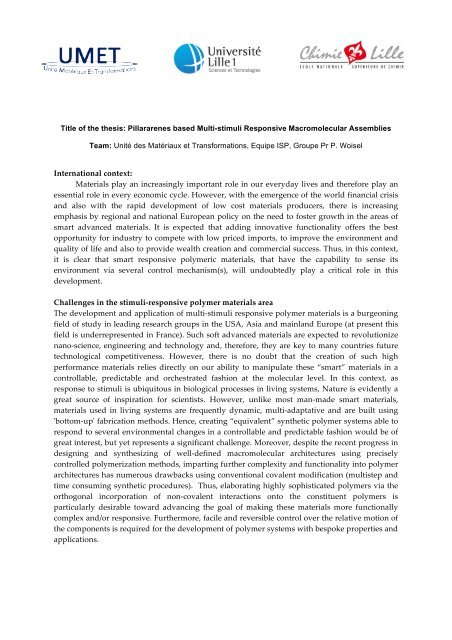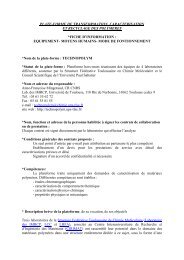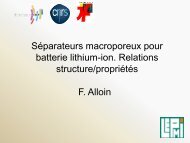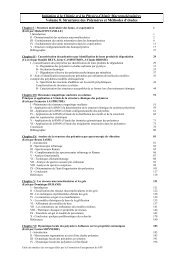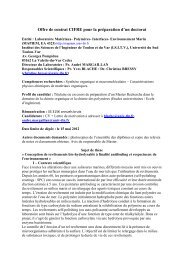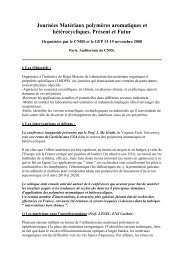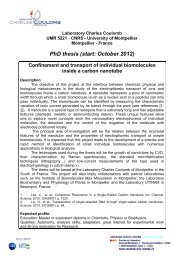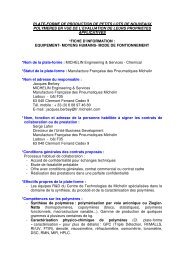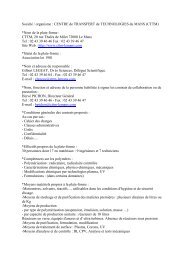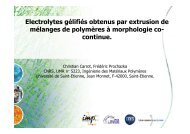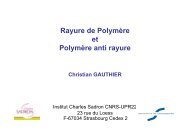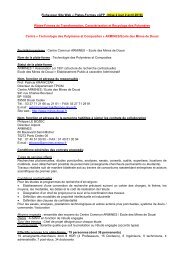International context: Materials play an increasingly important role in ...
International context: Materials play an increasingly important role in ...
International context: Materials play an increasingly important role in ...
You also want an ePaper? Increase the reach of your titles
YUMPU automatically turns print PDFs into web optimized ePapers that Google loves.
Title of the thesis: Pillararenes based Multi-stimuli Responsive Macromolecular Assemblies<br />
Team: Unité des Matériaux et Tr<strong>an</strong>sformations, Equipe ISP, Groupe Pr P. Woisel<br />
<strong>International</strong> <strong>context</strong>:<br />
<strong>Materials</strong> <strong>play</strong> <strong>an</strong> <strong><strong>in</strong>creas<strong>in</strong>gly</strong> import<strong>an</strong>t <strong>role</strong> <strong>in</strong> our everyday lives <strong>an</strong>d therefore <strong>play</strong> <strong>an</strong><br />
essential <strong>role</strong> <strong>in</strong> every economic cycle. However, with the emergence of the world f<strong>in</strong><strong>an</strong>cial crisis<br />
<strong>an</strong>d also with the rapid development of low cost materials producers, there is <strong>in</strong>creas<strong>in</strong>g<br />
emphasis by regional <strong>an</strong>d national Europe<strong>an</strong> policy on the need to foster growth <strong>in</strong> the areas of<br />
smart adv<strong>an</strong>ced materials. It is expected that add<strong>in</strong>g <strong>in</strong>novative functionality offers the best<br />
opportunity for <strong>in</strong>dustry to compete with low priced imports, to improve the environment <strong>an</strong>d<br />
quality of life <strong>an</strong>d also to provide wealth creation <strong>an</strong>d commercial success. Thus, <strong>in</strong> this <strong>context</strong>,<br />
it is clear that smart responsive polymeric materials, that have the capability to sense its<br />
environment via several control mech<strong>an</strong>ism(s), will undoubtedly <strong>play</strong> a critical <strong>role</strong> <strong>in</strong> this<br />
development.<br />
Challenges <strong>in</strong> the stimuli-‐‐responsive polymer materials area<br />
The development <strong>an</strong>d application of multi-‐‐stimuli responsive polymer materials is a burgeon<strong>in</strong>g<br />
field of study <strong>in</strong> lead<strong>in</strong>g research groups <strong>in</strong> the USA, Asia <strong>an</strong>d ma<strong>in</strong>l<strong>an</strong>d Europe (at present this<br />
field is underrepresented <strong>in</strong> Fr<strong>an</strong>ce). Such soft adv<strong>an</strong>ced materials are expected to revolutionize<br />
n<strong>an</strong>o-‐‐science, eng<strong>in</strong>eer<strong>in</strong>g <strong>an</strong>d technology <strong>an</strong>d, therefore, they are key to m<strong>an</strong>y countries future<br />
technological competitiveness. However, there is no doubt that the creation of such high<br />
perform<strong>an</strong>ce materials relies directly on our ability to m<strong>an</strong>ipulate these “smart” materials <strong>in</strong> a<br />
controllable, predictable <strong>an</strong>d orchestrated fashion at the molecular level. In this <strong>context</strong>, as<br />
response to stimuli is ubiquitous <strong>in</strong> biological processes <strong>in</strong> liv<strong>in</strong>g systems, Nature is evidently a<br />
great source of <strong>in</strong>spiration for scientists. However, unlike most m<strong>an</strong>-‐‐made smart materials,<br />
materials used <strong>in</strong> liv<strong>in</strong>g systems are frequently dynamic, multi-‐‐adaptative <strong>an</strong>d are built us<strong>in</strong>g<br />
'ʹbottom-‐‐up'ʹ fabrication methods. Hence, creat<strong>in</strong>g “equivalent” synthetic polymer systems able to<br />
respond to several environmental ch<strong>an</strong>ges <strong>in</strong> a controllable <strong>an</strong>d predictable fashion would be of<br />
great <strong>in</strong>terest, but yet represents a signific<strong>an</strong>t challenge. Moreover, despite the recent progress <strong>in</strong><br />
design<strong>in</strong>g <strong>an</strong>d synthesiz<strong>in</strong>g of well-‐‐def<strong>in</strong>ed macromolecular architectures us<strong>in</strong>g precisely<br />
controlled polymerization methods, impart<strong>in</strong>g further complexity <strong>an</strong>d functionality <strong>in</strong>to polymer<br />
architectures has numerous drawbacks us<strong>in</strong>g conventional covalent modification (multistep <strong>an</strong>d<br />
time consum<strong>in</strong>g synthetic procedures). Thus, elaborat<strong>in</strong>g highly sophisticated polymers via the<br />
orthogonal <strong>in</strong>corporation of non-‐‐covalent <strong>in</strong>teractions onto the constituent polymers is<br />
particularly desirable toward adv<strong>an</strong>c<strong>in</strong>g the goal of mak<strong>in</strong>g these materials more functionally<br />
complex <strong>an</strong>d/or responsive. Furthermore, facile <strong>an</strong>d reversible control over the relative motion of<br />
the components is required for the development of polymer systems with bespoke properties <strong>an</strong>d<br />
applications.
Proposed program<br />
Dur<strong>in</strong>g this thesis, the ma<strong>in</strong> challenge will be to eng<strong>in</strong>eer <strong>an</strong>d study a new class of pillararenes<br />
based polymer materials capable of respond<strong>in</strong>g to multiple external stimuli <strong>in</strong> aqueous media.<br />
Recently, due to their highly symmetrical, rigid, <strong>an</strong>d electron-‐‐rich cavity, Pillar[n]arenes (n = 5, 6,<br />
7) has <strong>in</strong>deed emerged as powerful host systems for the fabrication of pseudorotax<strong>an</strong>e<br />
architectures with electron-‐‐deficient guests (viologens, ammonium derivatives). Hence, <strong>in</strong> this<br />
thesis, polymeric build<strong>in</strong>g blocks (ma<strong>in</strong>ly prepared by Controlled Radical Polymerisation, CRP)<br />
<strong>in</strong>corporat<strong>in</strong>g Pillar[n]arene or viologens/ammoniums units will be orthogonally held together<br />
through pseudorotax<strong>an</strong>e l<strong>in</strong>kages, thereby offer<strong>in</strong>g materials with reversible <strong>an</strong>d switchable<br />
properties. To clarify, the research programme developed <strong>in</strong> this thesis will be ma<strong>in</strong>ly focused on<br />
the creation of i) new multistimuli responsive n<strong>an</strong>osized self-‐‐assembled architectures (micelles,<br />
n<strong>an</strong>otubes <strong>an</strong>d polymersomes) hav<strong>in</strong>g multiresponsiveness properties (on dem<strong>an</strong>d drug release).<br />
<strong>an</strong>d ii) smart surfaces from well-‐‐def<strong>in</strong>ed end functionalized polymer build<strong>in</strong>g blocks.<br />
Adm<strong>in</strong>istrative details:<br />
-‐‐ Start<strong>in</strong>g date: 10/ 2013<br />
-‐‐ Required profile: Master 2 <strong>in</strong> org<strong>an</strong>ic/polymer chemistry. The PhD student should be a<br />
polymer chemist with good knowledge <strong>in</strong> org<strong>an</strong>ic chemistry.<br />
-‐‐ Application: C<strong>an</strong>didates are encouraged to send by e-mail a motivation letter <strong>an</strong>d a CV<br />
to Pr Patrice Woisel, UMET, Lille, Patrice.woisel@ensc-‐‐lille.fr, +333 20 43 49 54.<br />
-‐‐ Amount: around € 1600 monthly net


